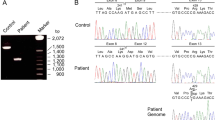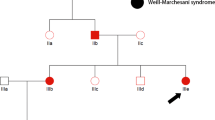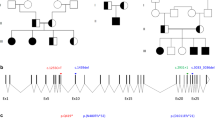Abstract
Triple-A syndrome (MIM 231550; also known as Allgrove syndrome) is an autosomal recessive disorder characterized by adrenocorticotropin hormone (ACTH)-resistant adrenal insufficiency, achalasia of the oesophageal cardia and alacrima1,2,3. Whereas several lines of evidence indicate that triple-A syndrome results from the abnormal development of the autonomic nervous system4,5,6, late-onset progressive neurological symptoms (including cerebellar ataxia, peripheral neuropathy and mild dementia) suggest that the central nervous system may be involved in the disease as well7,8. Using fine-mapping based on linkage disequilibrium in North African inbred families, we identified a short ancestral haplotype on chromosome 12q13 (<1 cM), sequenced a BAC contig encompassing the triple-A minimal region and identified a novel gene (AAAS) encoding a protein of 547 amino acids that is mutant in affected individuals. We found five homozygous truncating mutations in unrelated patients and ascribed the founder effect in North African families to a single splice-donor site mutation that occurred more than 2,400 years ago. The predicted product of AAAS, ALADIN (for alacrima-achalasia-adrenal insufficiency neurologic disorder), belongs to the WD-repeat family of regulatory proteins, indicating a new disease mechanism involved in triple-A syndrome. The expression of the gene in both neuroendocrine and cerebral structures points to a role in the normal development of the peripheral and central nervous systems.
This is a preview of subscription content, access via your institution
Access options
Subscribe to this journal
Receive 12 print issues and online access
$209.00 per year
only $17.42 per issue
Buy this article
- Purchase on Springer Link
- Instant access to full article PDF
Prices may be subject to local taxes which are calculated during checkout




Similar content being viewed by others
Accession codes
References
Allgrove, J., Clayden, G.S., Grant, D.B. & Macaulays, J.C. Familial glucocorticoid deficiency with achalasia of the cardia and deficient tear production. Lancet 1, 1284–1286 (1978).
Ehrlich, E., Aranoff, G. & Johnson, W.G. Familial achalasia associated with adrenocortical insufficiency, alacrima and neurological abnormalities. Am. J. Med. Genet. 26, 637–644 (1987).
Moore, P.S., Couch, R.M., Perry, Y.S., Shuckett, E.P. & Winter, J.S. Allgrove syndrome: an autosomal recessive syndrome of ACTH insensitivity, achalasia and alacrima. Clin. Endocrinol. (Oxf.) 34, 107–114 (1991).
Chu, M.L., Berlin, D. & Axelrod, F.B. Allgrove syndrome: documenting cholinergic dysfunction by autonomic tests. J. Pediatr. 129, 156–159 (1996).
Weber, A., Farrall, M., Dean, H.J. & Clark, A.J.L. Exclusion of the ACTH receptor and vasoactive intestinal peptide loci as candidate genes for the Triple A syndrome. Horm. Res. 44, 5 (1995).
Gazarian, M., Cowell, C.T., Bonney, M. & Grigor, W.G. The “4-A” syndrome: adrenocortical insufficiency associated with achalasia, alacrima, autonomic and other neurological abnormalities. Eur. J. Pediatr. 154, 18–23 (1995).
Grant, D.B., Dunger, D.B., Smith, I. & Hyland, K. Familial glucocorticoid deficiency with achalasia of the cardia, associated with mixed neuropathy, long-tract degeneration and mild dementia. Eur. J. Pediatr. 151, 85–89 (1992).
Heinrichs, C. et al. Familial adrenocorticotropin unresponsiveness associated with alacrima and achalasia: biochemical and molecular studies in two siblings with clinical heterogeneity. Eur. J. Pediatr. 154, 191–196 (1995).
Weber, A. et al. Linkage of the gene for the Triple A syndrome to chromosome 12q13 near the type II keratin gene cluster. Hum. Mol. Genet. 5, 2061–2066 (1996).
Stratakis, C.A. et al. Segregation of Allgrove (Triple-A) syndrome in Puerto Rican kindreds with chromosome 12 (12q13) polymorphic markers. Proc. Assoc. Am. Physicians 109, 478–482 (1997).
Hadj-Rabia, S. et al. Linkage disequilibrium in an inbred North African population allows fine genetic and physical mapping of Triple A syndrome. Eur. J. Hum. Genet. 8, 613–620 (2000).
Piccolo, F. et al. A founder mutation in the γ-sarcoglycan gene of Gypsies possibly predating their migration out of India. Hum. Mol. Genet. 5, 2019–2022 (1996).
Bittles, A.H., Mason, W.M., Greene, J. & Rao, N.A. Reproductive behavior and health in consanguineous marriages. Science 252, 789–794 (1991).
Neer, E.J., Schmidt, C.J., Nambudripad, R. & Temple, F.S. The ancient regulatory-protein of WD-repeat protein family. Nature 371, 297–300 (1994).
Reiner, O., Smith, T.F. & Neer, E.J. Folding of proteins with WD-repeats: comparison of six members of the WD-repeat superfamily to the G protein beta subunit. Biochemistry 35, 13985–13994 (1996).
Smith, T.F., Gaitatzes, C., Saxena, K. & Neer, E.J. The WD repeat: a common architecture for diverse functions. Trends Biochem. Sci. 24, 181–185 (1999).
Clark, A.J.L. & Weber, A. Adrenocorticotropin insensitivity syndromes. Endocr. Rev. 19, 828–843 (1998).
Naville, D. et al. Demonstration by transfection studies that mutations in the adrenocorticotropin receptor gene are one cause of the hereditary syndrome of glucocorticoid deficiency. J. Clin. Endocr. Metab. 81, 1442–1448 (1996).
Henning, K.A. et al. The Cockayne syndrome group A gene encodes a WD repeat protein that interacts with CSB protein and a subunit of RNA polymerase II TFIIH. Cell 82, 555–564 (1995).
Dib, C. et al. A comprehensive genetic map of the human genome based on 5,264 microsatellites. Nature 380, 152–154 (1996).
Belin, V. et al. SHOX mutations in dyschondrosteosis (Leri-Weill syndrome). Nature Genet. 19, 67–69 (1998).
Chumakov, I.M. et al. A YAC contig map of the human genome. Nature 377, 175–197 (1993).
Burke, D.T. The role of yeast artificial chromosome clones in generating genome maps. Curr. Opin. Genet. Dev. 1, 69–74 (1991).
Osoegawa, K. et al. An improved approach for construction of bacterial artificial chromosome libraries. Genomics 52, 1–8 (1998).
Acknowledgements
We thank O. Poch, J.M. Van der Winden, A. Rotschild, J. Zlotogora, J.C. Carel, P.F. Bougnères, C. Goizet, D. Lacombe, C. Weill, P. Adiceam, R. Brauner, P. Chatelain, Y. Le Bouc, D. Rieu, M. Dumic, M. Pombo, R. Sandrini and L. de Lacerda for discussions, referring patients and support; and G. Gyapay, T. Attié-Bitach, J.M. Rozet, H. El Shanti, O. Gribouval, M. Dailhat, X. Ferrera and Y. Deris for discussions and help in preparing this manuscript. This work was supported by grants from the AFM and the Assistance Publique-Hôpitaux de Paris (AOA95).
Author information
Authors and Affiliations
Corresponding author
Rights and permissions
About this article
Cite this article
Tullio-Pelet, A., Salomon, R., Hadj-Rabia, S. et al. Mutant WD-repeat protein in triple-A syndrome. Nat Genet 26, 332–335 (2000). https://doi.org/10.1038/81642
Received:
Accepted:
Issue Date:
DOI: https://doi.org/10.1038/81642
This article is cited by
-
SCARB1 downregulation in adrenal insufficiency with Allgrove syndrome
Orphanet Journal of Rare Diseases (2023)
-
Architecture and composition of plant nucleopore complexes, comparisons with putative homologs across kingdoms
The Nucleus (2023)
-
A review of the genetic spectrum of hereditary spastic paraplegias, inherited neuropathies and spinal muscular atrophies in Africans
Orphanet Journal of Rare Diseases (2022)
-
Protein signature of human skin fibroblasts allows the study of the molecular etiology of rare neurological diseases
Orphanet Journal of Rare Diseases (2021)
-
Disorders of the enteric nervous system — a holistic view
Nature Reviews Gastroenterology & Hepatology (2021)



